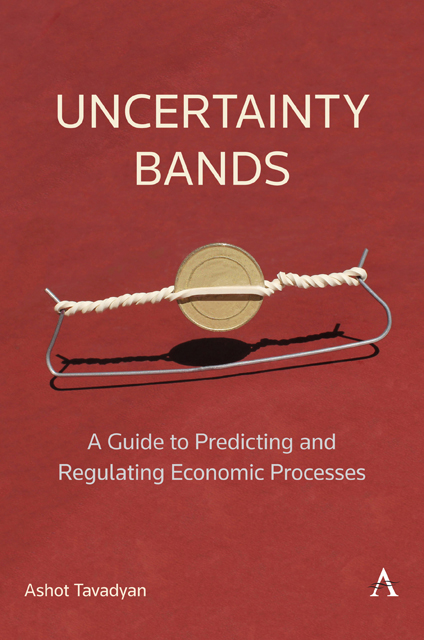Book contents
- Frontmatter
- Contents
- Preface
- Introduction: The Philosophy of Economic Forecasting
- 1 Interval Links in Economy and the Capabilities of Quantitative Thinking
- 2 The Possibilities for Forecasting Economic Indicators
- 3 The Principle of the Minimal Uncertainty Interval
- 4 The Intervals of Key Economic Indicators
- 5 Key Principles of Economic Regulation
- Conclusion
- Appendix: The Uncertainty Relations of Economic Indicators
- Acknowledgments
- Index
3 - The Principle of the Minimal Uncertainty Interval
Published online by Cambridge University Press: 09 December 2022
- Frontmatter
- Contents
- Preface
- Introduction: The Philosophy of Economic Forecasting
- 1 Interval Links in Economy and the Capabilities of Quantitative Thinking
- 2 The Possibilities for Forecasting Economic Indicators
- 3 The Principle of the Minimal Uncertainty Interval
- 4 The Intervals of Key Economic Indicators
- 5 Key Principles of Economic Regulation
- Conclusion
- Appendix: The Uncertainty Relations of Economic Indicators
- Acknowledgments
- Index
Summary
The Minimal Uncertainty Intervals of Economic Indicators
To have an unattainable exact forecast or an achievable forecast in the minimal interval?
The interval uncertainty of key economic indicators represents the infeasibility to pinpoint an economic indicator within the minimal uncertainty interval. The probability of the minimal interval may change, and the interval will have to be adjusted. The minimal uncertainty interval should not be equated to the confidence interval; the uncertainty interval is not the mean value of an indicator with a statistical estimate of the probability of its deviation.
The presented uncertainty interval should not be regarded as a purely statistical tool with which it is possible, as in other intervals, to estimate the probability of a particular parameter of the population. Economic indicators are always changing, and their parameters and distributions also change over time. Not to mention the substantial amount of noise generated by the markets. Considering the factor of heterogeneity of economic indicators and in most cases small samples, the exact calculation of probabilities or p-values of one or another indicator is meaningless.
All outcomes are possible in the uncertainty interval; their probability is indefinable; a point estimate and the mean are an artifice in the interval. The mean or the average often gives the illusion of stability. The concept of the average is inefficient; the key here is the minimal uncertainty interval.
The average value is usually uninformative. The information can be obtained with the uncertainty interval and, of course, with an estimate of the likelihood of serious repercussions when exiting a said interval. Even if some value is declared as an average, the likelihood of its fulfillment does not become higher or more preferable than other possible values within the interval. Indeed, this expression is appropriate here: do not jump off ledges in the dark if their average is a meter or three feet.
When inflation is expected to be between 2 and 5 percent, this does not mean that the likelihood of the average, which is 3.5 percent, will exceed 3 percent. For illustrative purposes, let's assume that the weather will change and the air temperature will drop by 4–6 degrees; this does not mean that the likelihood of 5 degrees is greater than 5.5 degrees. Moreover, the conse-quences of exiting the interval are quite different here.
- Type
- Chapter
- Information
- Uncertainty BandsA Guide to Predicting and Regulating Economic Processes, pp. 27 - 40Publisher: Anthem PressPrint publication year: 2022



